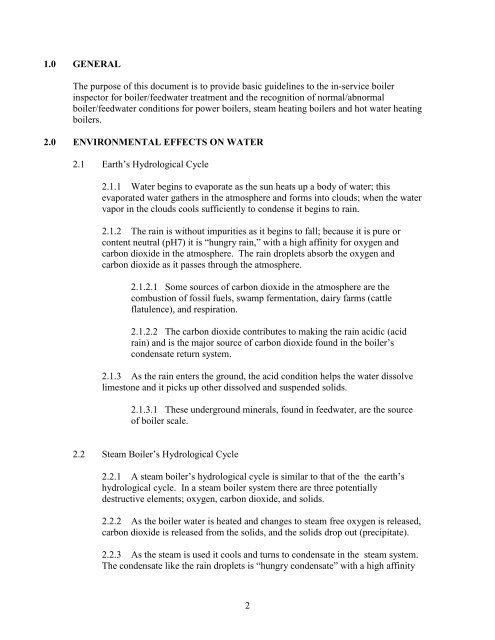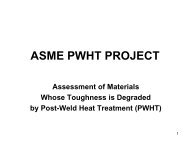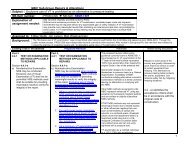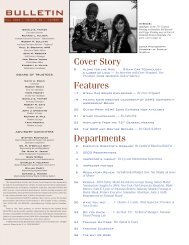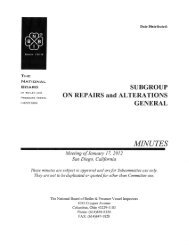DRAFT BOILER/FEEDWATER GUIDELINES - The National Board of ...
DRAFT BOILER/FEEDWATER GUIDELINES - The National Board of ...
DRAFT BOILER/FEEDWATER GUIDELINES - The National Board of ...
You also want an ePaper? Increase the reach of your titles
YUMPU automatically turns print PDFs into web optimized ePapers that Google loves.
1.0 GENERAL<br />
<strong>The</strong> purpose <strong>of</strong> this document is to provide basic guidelines to the in-service boiler<br />
inspector for boiler/feedwater treatment and the recognition <strong>of</strong> normal/abnormal<br />
boiler/feedwater conditions for power boilers, steam heating boilers and hot water heating<br />
boilers.<br />
2.0 ENVIRONMENTAL EFFECTS ON WATER<br />
2.1 Earth’s Hydrological Cycle<br />
2.1.1 Water begins to evaporate as the sun heats up a body <strong>of</strong> water; this<br />
evaporated water gathers in the atmosphere and forms into clouds; when the water<br />
vapor in the clouds cools sufficiently to condense it begins to rain.<br />
2.1.2 <strong>The</strong> rain is without impurities as it begins to fall; because it is pure or<br />
content neutral (pH7) it is “hungry rain,” with a high affinity for oxygen and<br />
carbon dioxide in the atmosphere. <strong>The</strong> rain droplets absorb the oxygen and<br />
carbon dioxide as it passes through the atmosphere.<br />
2.1.2.1 Some sources <strong>of</strong> carbon dioxide in the atmosphere are the<br />
combustion <strong>of</strong> fossil fuels, swamp fermentation, dairy farms (cattle<br />
flatulence), and respiration.<br />
2.1.2.2 <strong>The</strong> carbon dioxide contributes to making the rain acidic (acid<br />
rain) and is the major source <strong>of</strong> carbon dioxide found in the boiler’s<br />
condensate return system.<br />
2.1.3 As the rain enters the ground, the acid condition helps the water dissolve<br />
limestone and it picks up other dissolved and suspended solids.<br />
2.1.3.1 <strong>The</strong>se underground minerals, found in feedwater, are the source<br />
<strong>of</strong> boiler scale.<br />
2.2 Steam Boiler’s Hydrological Cycle<br />
2.2.1 A steam boiler’s hydrological cycle is similar to that <strong>of</strong> the the earth’s<br />
hydrological cycle. In a steam boiler system there are three potentially<br />
destructive elements; oxygen, carbon dioxide, and solids.<br />
2.2.2 As the boiler water is heated and changes to steam free oxygen is released,<br />
carbon dioxide is released from the solids, and the solids drop out (precipitate).<br />
2.2.3 As the steam is used it cools and turns to condensate in the steam system.<br />
<strong>The</strong> condensate like the rain droplets is “hungry condensate” with a high affinity<br />
2


